 Australian and Canadian Keys
Australian and Canadian Keys

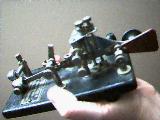
Several bugs other than the Simplex Auto were also made in Australia. This
Buzza Products Automatic Key No. 100 is an Australian bug. It is essentially
a double lever key; both pivots are visible in the photo. Other Australian
bugs included the McDonald Pendograph and the Shurdot, a very little known
bug made in Melbourne.

This little brown key was made famous by Dave Ingram in "Keys, Keys, Keys"
as the Australian Lifeboat Key. While it certainly seems plausible in
view of the rubber gasket around the shaft and the small size of the key,
that apparently is not the case. It certainly is marked "Aust No.1" and "AWA", the Australian Wireless Association
according to Ingram. But it seems more likely that "AWA" stands for "Amalgamated
Wireless Australasia," a radio-electronics company located in Australia. This key
is actually the "Key telegraph, Light Weight (Aust) No1", and was/is
part of WS No A510 kit, a manpack radio issued to the Australian Army in the 1950's, according
to Baz Ford, VK6MU.
Louise Ramsey Moreau W3WRE compiled a list of who was at the key to
transmit crucial news about what was happening during each of these
pivotal events in history. Click an event on the left to find out who
sent the news!
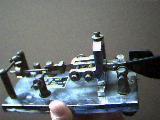
This chrome Dow Key has the support structure of the Vibroplex Original and
a damper bar like a Lightning bug, though with rounded
lines. It was made by Paul Dow of Winnipeg, Canada. Apparently, Dow Keys
were available beginning around 1949 and for several years thereafter. In
fact, some of the bugs were made in Minnesota after the company was moved.
According to Murray Willer's article in November 1988 QST magazine, Paul
Dow and Horace Martin were good friends. It was Paul Dow's demonstration
of the Vibroplex bug to the Western Union Telegraph Company that helped
convince that company to allow their operators to use bugs.
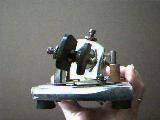
This is an end-on view of another bug, Paul Dow's tilted Dow Key.
The key just above, for comparison, is the straight Dow Key. Apparently,
the thought was that the operator would be more comfortable with the support
structure of the key tilted toward the right. Even the dit and dah contact
posts are tilted to the right. The posts and support structure somewhat
less massive than in the straight Dow Key, probably in order to allow for
the bend required.
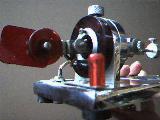
Apparently, there was no agreement on the best tilt for a Dow Key. Perhaps
some operators liked a little more or less tilt than on the fixed-tilted model.
This is the fully rotatable Dow Key. The set screw at top is loosened and
the whole support structure turns. The contact posts are replaced by
extensions of the support which are then wired back to screws in the base.
The wires are cloth covered to allow them to flex back and forth as the
support is rotated. This bug has colorful orange and red plastic parts
as opposed its less colorful predecessors. The rotatable Dow Key is
very similar in construction to the Lytle Triplex.
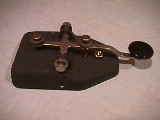
Dow-Key also made a straight key as a student's key. It is made of cast aluminum
and sold for $9.95 retail. The base is of an unusual trapezoidal shape and came in a
box with batteries, headphone, message blanks, and transistor circuit under the base
as an oscillator. The entire setup can be seen on the Dow-Key page of the N7CFO
Keyletter website.
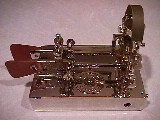
MacDonald made at least two different versions of his vertical bug, the Pendograph. These
were made around 1936. The straight version pictured here is probably the more common, but
there was also a right angle one. The Pendograph features a vertical pendulum anchored at the
bottom and dots fashioned by the Coffe release mechanism. The base is considerably thicker
than most semiautomatics. The Pendograph was made in Adelaide as was the Automorse Triple Lever.
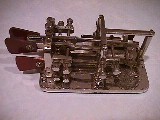
The Automorse is an interesting jigger. The top left paddle is a Vibroplex-style
repeating dit lever. The top right paddle is a Vibroplex-style dash post lever. The
bottom paddle is a Mecograph-style tension-releasing repeating dash lever! The
Automorse Triple Lever bug was made by Hitchcox Bros. of Adelaide, Australia.

There have been many means devised to communicate over long distances. Use your
mouse to touch the small green rectangle on the time line and move the date. You can see here
that pigeons have been used as a means of transmitting information longer than any other
modality, even used by engineers at Lockheed in 1981 to transmit rolls of film a
distance of 25 miles! Notice how short a span of time the optical semaphore telegraphs of Chappe and
Edelcrantz were used (you'll have to move the small green rectangle slowly to
the right), and
how comparatively short a period of time electrical telegraph and telephone have been used.
The optical telegraph was first documented in 1791 in France, and was its last documented
use was in Sebastopol in 1855. The electrical telegraph was first used in 1837 in America.
The data used here are from Holzmann and Pehrson's "The Early History of Data Networks", 1995,
IEEE Computer Society Press. The dates represent first and last recorded uses for each
form of communication.
 On to more keys
On to more keys
Back to the Index
 Australian and Canadian Keys
Australian and Canadian Keys
 Australian and Canadian Keys
Australian and Canadian Keys










